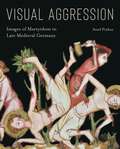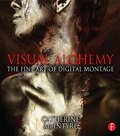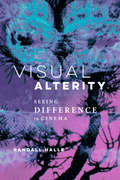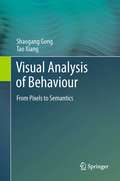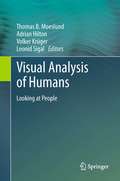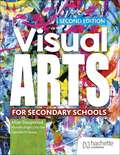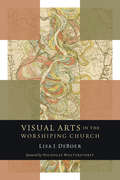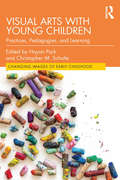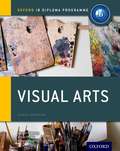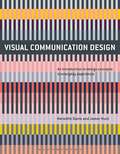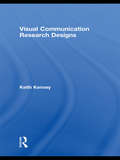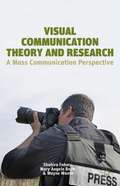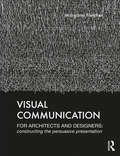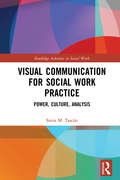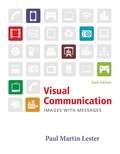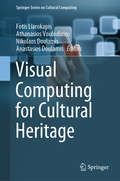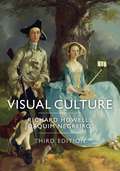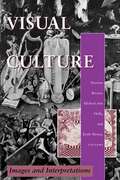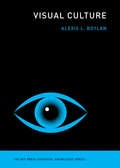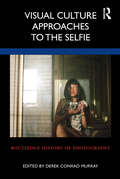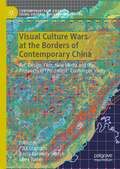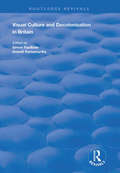- Table View
- List View
Visual Aggression: Images of Martyrdom in Late Medieval Germany
by Assaf PinkusWhy does a society seek out images of violence? What can the consumption of violent imagery teach us about the history of violence and the ways in which it has been represented and understood? Assaf Pinkus considers these questions within the context of what he calls galleries of violence, the torment imagery that flourished in German-speaking regions during the fourteenth and fifteenth centuries. Exploring these images and the visceral bodily responses that they produced in their viewers, Pinkus argues that the new visual discourse on violence was a watershed in premodern conceptualizations of selfhood.Images of martyrdom in late medieval Germany reveal a strikingly brutal parade of passion: severed heads, split skulls, mutilated organs, extracted fingernails and teeth, and myriad other torments. Stripped from their devotional context and presented simply as brutal acts, these portrayals assailed viewers’ bodies and minds so violently that they amounted to what Pinkus describes as “visual aggressions.” Addressing contemporary discourses on violence and cruelty, the aesthetics of violence, and the eroticism of the tortured body, Pinkus ties these galleries of violence to larger cultural concerns about the ethics of violence and bodily integrity in the conceptualization of early modern personhood.Innovative and convincing, this study heralds a fundamental shift in the scholarly conversation about premodern violence, moving from a focus on the imitatio Christi and the liturgy of punishment to the notion of violence as a moral problem in an ethical system. Scholars of medieval and early modern art, history, and literature will welcome and engage with Pinkus’s research for years to come.
Visual Alchemy: The Fine Art Of Digital Montage
by Catherine McIntyreCatherine McIntyre, like many fine artists, created traditional art for decades before encountering the versatility of digital imaging technology. Free of her Rotring pens and scalpel, she now uses Photoshop to create her montages. Visual Alchemy explores McIntyre’s sources of inspiration as well as her methods, offering an aesthetic guide to composition, color, texture and all of the other means of communication that artists have at their disposal. While these concepts and techniques make use of Photoshop, they will apply to any digital imaging program and indeed to any medium, whether traditional or digital. Featuring McIntyre’s own art as well as that of artists around the globe, Visual Alchemy is an invitation to discover the artistic possibilities of picture making through digital montage.
Visual Alterity: Seeing Difference in Cinema
by Randall HalleReconsidering the dynamics of perception Using cinema to explore the visual aspects of alterity, Randall Halle analyzes how we become cognizant of each other and how we perceive and judge another person in a visual field. Halle draws on insights from philosophy and recent developments in cognitive and neuroscience to argue that there is no pure "natural" sight. We always see in a particular way, from a particular vantage point, and through a specific apparatus, and Halle shows how human beings have used cinema to experiment with the apparatus of seeing for over a century. Visual alterity goes beyond seeing difference to being conscious of how one sees difference. Investigating the process allows us to move from mere perception to apperception, or conscious perception. Innovative and insightful, Visual Alterity merges film theory with philosophy and cutting-edge science to propose new ways of perceiving and knowing.
Visual Analysis of Behaviour
by Tao Xiang Shaogang GongThis book presents a comprehensive treatment of visual analysis of behaviour from computational-modelling and algorithm-design perspectives. Topics: covers learning-group activity models, unsupervised behaviour profiling, hierarchical behaviour discovery, learning behavioural context, modelling rare behaviours, and "man-in-the-loop" active learning; examines multi-camera behaviour correlation, person re-identification, and "connecting-the-dots" for abnormal behaviour detection; discusses Bayesian information criterion, Bayesian networks, "bag-of-words" representation, canonical correlation analysis, dynamic Bayesian networks, Gaussian mixtures, and Gibbs sampling; investigates hidden conditional random fields, hidden Markov models, human silhouette shapes, latent Dirichlet allocation, local binary patterns, locality preserving projection, and Markov processes; explores probabilistic graphical models, probabilistic topic models, space-time interest points, spectral clustering, and support vector machines.
Visual Analysis of Humans
by Leonid Sigal Thomas B. Moeslund Volker Krüger Adrian HiltonThis unique text/reference provides a coherent and comprehensive overview of all aspects of video analysis of humans. Broad in coverage and accessible in style, the text presents original perspectives collected from preeminent researchers gathered from across the world. In addition to presenting state-of-the-art research, the book reviews the historical origins of the different existing methods, and predicts future trends and challenges. Features: with a Foreword by Professor Larry Davis; contains contributions from an international selection of leading authorities in the field; includes an extensive glossary; discusses the problems associated with detecting and tracking people through camera networks; examines topics related to determining the time-varying 3D pose of a person from video; investigates the representation and recognition of human and vehicular actions; reviews the most important applications of activity recognition, from biometrics and surveillance, to sports and driver assistance.
Visual Arts for Secondary Schools Second Edition
by Allan Sieupresad Michelle Bright Chin-See Gabriella D’AbreauConfidently navigate the Visual Arts curricula across all secondary school years with a course that unifies foundational skills and CSEC exam practice, featuring clear visual guides and activities tailored for academic success and artistic growth.- Enhance CSEC readiness with a resource that incorporates the latest technologies and syllabus topics, guiding students through reflective journal and portfolio creation for exam success. - Foster accessible learning through the simplification of complex visual arts concepts with student-friendly language and step-by-step guidance, enhancing skill development across student levels. - Improve understanding of chapter content through practical skills and preparation for examination with research-based activities, collaborative and independent projects, and art appreciation or critique.
Visual Arts for Secondary Schools Second Edition
by Allan Sieupresad Michelle Bright Chin-See Gabriella D’AbreauConfidently navigate the Visual Arts curricula across all secondary school years with a course that unifies foundational skills and CSEC exam practice, featuring clear visual guides and activities tailored for academic success and artistic growth.- Enhance CSEC readiness with a resource that incorporates the latest technologies and syllabus topics, guiding students through reflective journal and portfolio creation for exam success. - Foster accessible learning through the simplification of complex visual arts concepts with student-friendly language and step-by-step guidance, enhancing skill development across student levels. - Improve understanding of chapter content through practical skills and preparation for examination with research-based activities, collaborative and independent projects, and art appreciation or critique.
Visual Arts in the Worshiping Church (Calvin Institute of Christian Worship Liturgical Studies)
by Nicholas Wolterstorff Lisa DeBoerAlthough numerous studies have examined biblical and theological rationales for using the visual arts in worship, this book by Lisa J. DeBoer fills in a piece of the picture missing so far — the social dimensions of both our churches and the various art worlds represented in our congregations. The first part of the book looks at Orthodoxy, Catholicism, and Protestantism in turn — including case studies of specific congregations — showing how each tradition’s use of the visual arts reveals an underlying ecclesiology. DeBoer then focuses on six themes that emerge when Orthodox, Catholic, and Protestant uses of the visual arts are examined together — the arts as expressions of the church’s local and universal character, the meanings attributed to particular styles of art for the church, the role of the arts in enculturating the gospel, and more. DeBoer’s Visual Arts in the Worshiping Church will focus and deepen the thinking of pastors, worship leaders, artists, students, and laypeople regarding what the arts might do in the midst of their congregations.
Visual Arts in the Worshiping Church (Calvin Institute of Christian Worship Liturgical Studies)
by Lisa DeBoerAlthough numerous studies have examined biblical and theological rationales for using the visual arts in worship, this book by Lisa J. DeBoer fills in a piece of the picture missing so far — the social dimensions of both our churches and the various art worlds represented in our congregations. The first part of the book looks at Orthodoxy, Catholicism, and Protestantism in turn — including case studies of specific congregations — showing how each tradition&’s use of the visual arts reveals an underlying ecclesiology. DeBoer then focuses on six themes that emerge when Orthodox, Catholic, and Protestant uses of the visual arts are examined together — the arts as expressions of the church&’s local and universal character, the meanings attributed to particular styles of art for the church, the role of the arts in enculturating the gospel, and more. DeBoer&’s Visual Arts in the Worshiping Church will focus and deepen the thinking of pastors, worship leaders, artists, students, and laypeople regarding what the arts might do in the midst of their congregations.
Visual Arts with Young Children: Practices, Pedagogies, and Learning (Changing Images of Early Childhood)
by Christopher M. Schulte Hayon ParkFeaturing the work of leading scholar-practitioners, Visual Arts with Young Children raises critical questions about the situated nature of the visual arts and its education in early childhood. Innovative chapters explore the relationship of place to art practice and pedagogy, culturally-responsive and justice-oriented perspectives, as well as critical and reconceptualist approaches to materials, technology and media. Ideal for researchers and students of both early childhood education and arts integration programs, this volume is an essential step towards a deeper understanding of how visual arts are understood, valued and practiced in the early years.
Visual Arts: Course Companion (Oxford IB Diploma Programme)
by Andrew Vaughan Jayson Paterson Simon PoppyStrengthen potential in IB Visual Arts. The only resource matched to the IB Visual Arts Guide, this essential Course Book breaks down and clarifies all the assessment components of the course. Guiding learners through each assessment task, a range of artwork examples contextualize the exam criteria, reinforcing comprehension and confidence. Build assessment potential enable learners to fully understand and engage with all the assessment tasks Develop exam strategies equip students with tested means to develop ideas and evaluate their work Drive reflective learning built-in TOK links, questions and discussion points help you fully adopt the IB approach to learning Fully matched to the most recent IB Visual Guide for first examination 2016.
Visual Character Development in Film and Television: Your Character is Your Canvas
by Michael Hanly Elisabeth RowneyThis book takes a unique look at visual character development in motion pictures and television by using famous works of art combined with modern works of film and television to demonstrate how to weave a visual tale. In a single shot or scene, what should we reveal about a character? What should we conceal? How can we show a character’s progression over time? In Visual Character Development in Film and Television, authors Michael Hanly and Elisabeth Rowney explain how to create compelling visual characters for the screen by analyzing fine art aesthetics and combining them with modern cinematic techniques. Full-color chapters cover character-driven approaches to costume design and makeup application, production design, cinematography and lighting, plot development, editing considerations, and more. By exploring how surroundings, habits, lifestyles – even the color of a sweater – can tell us more about a character on the screen than what can be said in dialogue alone, this book will prove a valuable resource for anyone wanting to take their filmmaking to the next level.
Visual Communication Design: An Introduction To Design Concepts In Everyday Experience (Required Reading Range #75)
by Meredith Davis Jamer HuntThis book traces the origins of visual phenomena and principles for the arrangement of form by providing examples that encounter in going about the daily lives. The authors provide a new slant on design basics from the perspective of audiences and users. Chapters break down interactions with communication as a sequence of meaningful episodes, each with related visual concepts that shape the interpretive experience. Explanatory illustrations and professional design examples support definitions of visual concepts and discussions of context. Work spans print, screen and environmental applications from around the world.
Visual Communication Research Designs
by Keith KenneyVisual Communication Research Designs provides a step-by-step guide for designing research involving visuals relevant to communications media. This volume explains the process from conceptualization to research questions, instrumentation, analysis, and reliability and validity checks. It also addresses the lack of sufficient methods to answer theoretical questions attending visual communication. This resource has been developed in response to the circumstance in which, in many cases, the methodologies used for verbal and textual communications are inappropriate or ineffective when applied or adapted for the study of visual communications. Additionally, research articles from ethnography, action research, rhetoric, semiotics, psychology, cultural studies, and critical theory often do not use examples appropriate to visual communication readers. To address these issues, this book explains in clear and straightforward language key research designs, including new methodologies, that are appropriate for scholars and students conducting visual communication research. Organized into three parts -- production, analysis, and effects of visuals – this research text provides guidance in using, interpreting and measuring the effects of visual images. It addresses such topics as: producing photographs and video that can be used as research data; interpreting images that already exist; measuring the effects of visuals and to understand their use by different groups. Ethical issues are included, as well as a discussion of the advantages and limitations of each method. "War stories" are provided by experienced researchers, who discuss a particular research project and explain pitfalls to avoid, as well as what to do when problems occur. The primary audiences are scholars, researchers, and students conducting research on motion pictures, video, television, photographs, illustrations, graphics, typography, political cartoons, comic books, animation, and other media with a visual component. Individuals will use this text whenever they need to conduct research that involves visuals in the media. The book will be a required text for advanced courses in visual culture, seminars on visual communication research, and other research methods courses integrating a visual component.
Visual Communication Theory And Research
by Shahira Fahmy Mary Angela Bock Wayne WantaIn today's multimedia environment, visuals are essential and expected parts of storytelling. However, the visual communication research field is fragmented into several sub-areas, making study difficult. Fahmy, Bock, and Wanta note trends and discuss the challenges of conducting analysis of images across print, broadcast, and online media.
Visual Communication for Architects and Designers: Constructing the Persuasive Presentation
by Margaret FletcherVisual Communication for Architects and Designers teaches you the art of designing a concise, clear, compelling and effective visual and verbal presentation. Margaret Fletcher has developed a reference manual of best practices that gives you the necessary tools to present your work in the best way possible. It includes an impressive 750 presentation examples by over 180 designers from 24 countries in North America, South America, Europe, the Middle East, Asia, Oceania and Africa. This book offers actionable advice to solve a variety of complex presentation challenges. You will learn how to: Understand differences in communication design, representation design and presentation design and know how to use these skills to your advantage; Structure the visual and verbal argument in your presentation; Design your presentation layouts, architectural competitions, boards and digital presentations; Manage issues related to the presentation of architectural and design ideas; Present yourself professionally. Your ability to communicate your design ideas to others is an invaluable and important skill. Visual Communication for Architects and Designers shows you how to develop and implement these skills and gain command of your presentations.
Visual Communication for Social Work Practice: Power, Culture, Analysis (Routledge Advances in Social Work)
by Sonia M. TascónHow are we to understand how the dominance of visual images and representations in late modernity affects Social Work practice, research and education? Social workers are increasingly using still and moving images to illustrate their work, to create new knowledge, and to further specific groups’ interests. As a profession in which communication is central, visual practices are becoming ever more significant as they seek to carry out their work with, and for, the marginalised and disenfranchised. It is time for the profession to gain more critical, analytical, and practical knowledge of visual culture and communication, in order to use and create images in accordance with its central principle of social justice. That requires an understanding of them beyond representation. As important as this is, it is also where the profession’s scholarly work in this area has remained and halted, and thus understanding of the work of images in our practices is limited. In order to more fully understand images and their effects – both ideologically and experientially – social workers need to bring to bear other areas of study such as reception studies, visual phenomenology, and the gaze. These other analytical frames enable a consideration not only of images per se, but also of their effect on the viewer, the human spectators, and the subjects at the heart of Social Work. By bringing understandings and experiences in Film, Media, and Communications, Visual Communication for Social Work Practice provides the reader with a wide range of critically analytical frames for practitioners, activists, educators, and researchers as they use and create images. This invites a deeper knowledge and familiarity with the power dimensions of the image, thus aligning with the social justice dimension of Social Work. Examples are provided from cinema, popular media, but more importantly from Social Work practitioners themselves to demonstrate what has already been made possible as they create and use images to further the interpersonal, communal, and justice dimensions of their work. This book will be of interest to scholars, students, and social workers, particularly those with an interest in critical and creative methodologies.
Visual Communication: Images with Messages
by Paul LesterVisual communication is just as important as verbal communication, if not more so. VISUAL COMMUNICATION: IMAGES WITH MESSAGES shows you how visual perception is used in all forms of communication, whether it's graphic design, photography, television, video, or interactive media. In addition, this 6th edition is presented in full color from cover to cover. And because it's packed with study and review tools, it not only clearly explains the theories you need to know, it helps you prepare for tests and will help you succeed in the class.
Visual Computing for Cultural Heritage (Springer Series on Cultural Computing)
by Anastasios Doulamis Fotis Liarokapis Athanasios Voulodimos Nikolaos DoulamisThis book provides insights into the state of the art of digital cultural heritage using computer graphics, image processing, computer vision, visualization and reconstruction, virtual and augmented reality and serious games. It aims at covering the emergent approaches for digitization and preservation of Cultural Heritage, both in its tangible and intangible facets. Advancements in Digital Cultural Heritage research have been abundant in recent years covering a wide assortment of topics, ranging from visual data acquisition, pre-processing, classification, analysis and synthesis, 3D modelling and reconstruction, semantics and symbolic representation, metadata description, repository and archiving, to new forms of interactive and personalized presentation, visualization and immersive experience provision via advanced computer graphics, interactive virtual and augmented environments, serious games and digital storytelling. Different aspects pertaining to visual computing with regard to tangible (books, images, paintings, manuscripts, uniforms, maps, artefacts, archaeological sites, monuments) and intangible (e.g. dance and performing arts, folklore, theatrical performances) cultural heritage preservation, documentation, protection and promotion are covered, including rendering and procedural modelling of cultural heritage assets, keyword spotting in old documents, drone mapping and airborne photogrammetry, underwater recording and reconstruction, gamification, visitor engagement, animated storytelling, analysis of choreographic patterns, and many more. The book brings together and targets researchers from the domains of computing, engineering, archaeology and the arts, and aims at underscoring the potential for cross-fertilization and collaboration among these communities.
Visual Culture
by Richard Howells Joaquim NegreirosThis is a book about how to read visual images: from fine art to photography, film, television and new media. It explores how meaning is communicated by the wide variety of texts that inhabit our increasingly visual world. But, rather than simply providing set meanings to individual images, Visual Culture teaches readers how to interpret visual texts with their own eyes. While the first part of the book takes readers through differing theoretical approaches to visual analysis, the second part shifts to a medium-based analysis, connected by an underlying theme about the complex relationship between visual culture and reality. The book is an ideal introduction for students taking courses in visual culture and communications in a range of disciplines, including media and cultural studies, sociology, and art and design.
Visual Culture
by Norman Bryson Michael Ann Holly Keith Moxey"We can no longer see, much less teach, transhistorical truths, timeless works of art, and unchanging critical criteria without a highly developed sense of irony about the grand narratives of the past," declare the editors, who also coedited Visual Theory: Painting and Interpretation (1990). The field of art history is not unique in finding itself challenged and enlarged by cultural debates over issues of class, ethnicity, nationality, sexual orientation, and gender. Visual Culture assembles some of the foremost scholars of cultural studies and art history to explore new critical approaches to a history of representation seen as something different from a history of art.CONTRIBUTORS: Andres Ross, Michael Ann Holly, Mieke Bal, David Summers, Constance Penley, Kaja Silverman, Ernst Van Alphen, Norman Bryson, Wolfgang Kemp, Whitney Davis, Thomas Crow, Keith Moxey, John Tagg, Lisa Tickner.Ebook Edition Note: Ebook edition note: all illustrations have been redacted.
Visual Culture (The MIT Press Essential Knowledge Series)
by Alexis L. BoylanAs if John Berger's Ways of Seeing was re-written for the 21st century, Alexis L. Boylan crafts a guide for navigating the complexities of visual culture in this concise introduction. The visual surrounds us, some of it invited, most of it not. In this visual environment, everything we see--art, color, the moon, a skyscraper, a stop sign, a political poster, rising sea levels, a photograph of Kim Kardashian West--somehow becomes legible, normalized, accessible. How does this happen? How do we live and move in our visual environments? This volume offers a guide for navigating the complexities of visual culture, outlining strategies for thinking about what it means to look and see--and what is at stake in doing so.
Visual Culture Approaches to the Selfie (Routledge History of Photography)
by Derek Conrad MurrayThis collection explores the cultural fascination with social media forms of self-portraiture, "selfies," with a specific interest in online self-imaging strategies in a Western context. This book examines the selfie as a social and technological phenomenon but also engages with digital self-portraiture as representation: as work that is committed to rigorous object-based analysis. The scholars in this volume consider the topic of online self-portraiture—both its social function as a technology-driven form of visual communication, as well as its thematic, intellectual, historical, and aesthetic intersections with the history of art and visual culture. This book will be of interest to scholars of photography, art history, and media studies.
Visual Culture Wars at the Borders of Contemporary China: Art, Design, Film, New Media and the Prospects of “Post-West” Contemporaneity (Contemporary East Asian Visual Cultures, Societies and Politics)
by Paul Gladston Beccy Kennedy-Schtyk Ming TurnerThis edited collection brings together essays that share in a critical attention to visual culture as a means of representing, contributing to and/or intervening with discursive struggles and territorial conflicts currently taking place at and across the outward-facing and internal borders of the People’s Republic of China. Elucidated by the essays collected here for the first time is a constellation of what might be described as visual culture wars comprising resistances on numerous fronts not only to the growing power and expansiveness of the Chinese state but also the residues of a once pervasively suppressive Western colonialism/imperialism. The present volume addresses visual culture related to struggles and conflicts at the borders of Hong Kong, the South China Sea and Taiwan as well within the PRC with regard the so-called “Great Firewall of China” and differences in discursive outlook between China and the West on the significances of art, technology, gender and sexuality. In doing so, it provides a vital index of twenty-first century China’s diversely conflicted status as a contemporary nation-state and arguably nascent empire.
Visual Culture and Decolonisation in Britain (Routledge Revivals)
by Anandi RamamurthyFirst published in 2006, this volume provides the first in-depth analysis of the place of visual representations within the process of decolonisation during the period 1945 to 1970. The chapters trace the way in which different visual genres – art, film, advertising, photography, news reports and ephemera – represented and contributed to the political and social struggles over Empire and decolonisation during the mid-Twentieth century. The book examines both the direct visual representation of imperial retreat after 1945 as well as the reworkings of imperial and ‘racial’ ideologies within the context of a transformed imperialism. While the book engages with the dominant archive of artists, exhibitions, newsreels and films, it also explores the private images of the family album as well as examining the visual culture of anti-colonial resistance.
